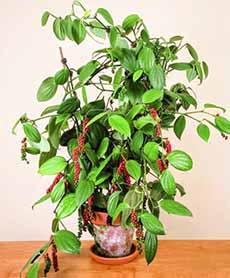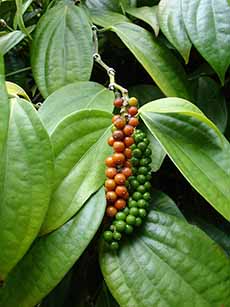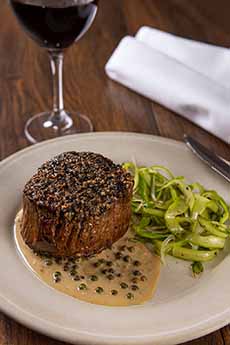|
Many people grow herbs at home. How about peppercorns?
If your Valentine has a green thumb, a peppercorn plant is a different kind of gift.
You can grow one as a houseplant (photo #1); or if you live in a semi-tropical climate, you can grow it outdoors (here’s what you need to know to grow the plant outdoors).
When grown as a houseplant, all it needs is moderate light in an east or west window.
Why grow a peppercorn plant at home?
It grows into a pretty plant with exotic clusters of berries (the peppercorns—photo #2).
You can harvest the berries and dry your own peppercorns.
It’s a novelty. Who else has one?
WHO WANTS A PEPPERCORN PLANT?
People who grow herbs.
People who enjoy plants in their homes or offices.
Cooks who appreciate the novelty.
You can easily find black peppercorn plants online.
The history of black pepper follows.
> The year’s peppercorn holidays are below.
THE MOST POPULAR SPICE IN THE WORLD
Black pepper is the most commonly used spice in the world. It has been used since antiquity for both seasoning and as a medicine.
Some might have guessed that salt is the most commonly used “spice,” but:
Salt is a mineral, not a spice. It comes from mining salt deposits left over from extinct bodies of water; or by dehydrating sea water (salt water).
Spices are either the seed, or part of the bark, fruit, root or other portion of a plant (saffron, for example, is the stigma of the saffron crocus flower).
Herbs are the leaves, flower buds/petals, or stems of plants used for flavoring or as a garnish.
The Origin Of Peppercorns
The black peppercorn plant (Piper nigrum) is native to India and is grown in other Southeastern Asian countries.
It is cultivated for its fruits—tiny berries with the peppercorn (the seed) inside. The berries mature from green to red (photo #2).
The berries are dried, and the fruit on the outside is removed, leaving the seed.
Black peppercorns are wrinkly due to the exocarp, a skin covering the seed.
White peppercorns have the black exocarp removed. You can see in photo #3 that white peppercorns are not wrinkled. Their purpose in formal cooking is to provide the flavor without the black specks from the exocarp, for example to avoid specks that would mar the appearance of a pure white sauce.
Green peppercorns keep the green fruit in a way that retains the green color (e.g. freeze-drying).
Pink peppercorns are not Piper nigrum. They’re berries from the baies rose plant (Schinus molle, family Anacardiaceae), a small mastic tree related to the rose bush. It grows on the French Island of Reunion in the Indian Ocean. Authentic red peppercorns from Piper nigrum are sold pickled/brined to preserve the red fruit, but difficult to find in the U.S.
There are numerous varieties of peppercorns.
Check out different types of pepper in our photo glossary of peppercorns and other “pepper.”
The spiciness of pepper is due to the organic compound piperine. (Chiles get their heat from capsaicin, an unrelated compound.)
THE YEAR’S PEPPERCORN HOLIDAYS
Also note the year’s 18 chile pepper holidays.
January 16: International Hot & Spicy Food Day
September 9: National Steak Au Poivre Day
November: National Pepper Month*
December 29: National Pepper Pot Day
________________
*This was founded to refer to chile peppers, but we claim it for peppercorns as well.
|
|

[1] Your plant (or seed pack) arrives, ready for tender loving care—and in the case of this plant, a good pruning (available at Logee’s)

[2] Piper nigrum grown into a full, glossy plant. The peppercorn clusters ripen at different rates, thus both reddish and green on this plant (available from Eternal Cover | Amazon).

[3] Imagine growing your own peppercorns for Steak au Poivre. Here’s the recipe (photo © Certified Angus Beef).

[4] Black and white peppercorns. The white peppercorns are the actual seed inside the black exocarp, which is removed so as not to leave black specks in elegant dishes (photo © Adam Kozlowski | iStock Photo).
|






